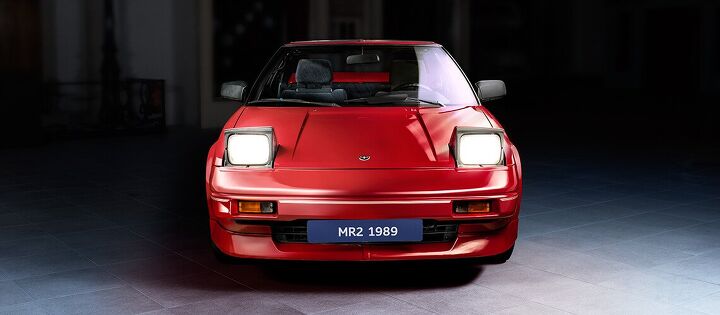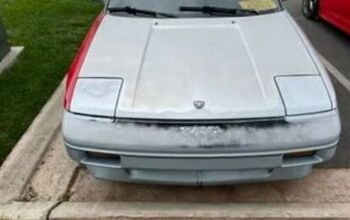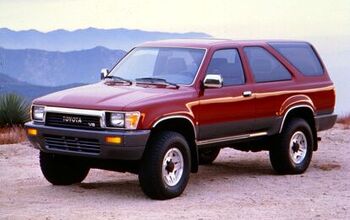Ace of Base Redux: 1989 Toyota MR2

On occasion, Ace of Base will scour the web for the details and minutiae of a ride from the past that we feel fits the Ace of Base ethos. This is one of those cars.
Offered in naturally aspirated and supercharged guises for 1989, the MR2 found itself in the last model year of its deliciously wedgy styling language. Travelling back in time to the late ‘80s, let’s find out what one could expect to get for their money in a base Toyota MR2.
Directly astern of the driver, the base MR2’s 1.6L DOHC inline-four was good for about 115 horsepower and less than 100 lb-ft of torque. Even by the lax standards of the mid/late ‘80s, this was not a quick car. It was, however, a happy car, more than glad to zing from idle to redline at any given prod of the go-pedal.
It was also a small car, just 155 inches in length with a 91-inch wheelbase, tipping the scales at 2350 pounds. That’s an impressive number, but consider this: nearly 30 years later, burdened with all manner of mandated safety nannies, airbags, and cries for modern touchscreen nav systems, Mazda’s MX-5 Miata still manages to weigh in at only 18 pounds heavier than the MR2. I think that underscores Mazda’s remarkable achievement with the newest MX-5. But I digress.
The MR2’s lightweight chassis featured MacPherson struts front and rear, discs on all four corners, and quick-ratio rack-and-pinion steering. The base MR2 had 56 percent of its 2350 pounds draped over the rear wheels, leading to great handling dynamics and general fling-ability.
At the time, most other interiors of mid-engined cars (think Pontiac Fiero, Ferrari 308, Fiat X1/9) were rife with ergonomic horrors and failed to provide enough space to comfortably change your mind, let alone change a gear. The MR2’s cockpit, in contrast, was a master class in ergonomics, particularly the ’87-’89 models that flipped the e-brake from one side of the transmission tunnel to the other for greater driver space, and deployed a sharp-looking three-spoke steering wheel with MR2 embossed in the centre pad.
To this jaundiced eye, there’s more than a hint of Ferrari Mondial in the MR2’s rear backlight, especially around the flying buttress and engine cover detail. Pop-up headlights (which will never make a return — thanks a lot, pedestrian safety laws) still look cool today, and I confess to being a sucker for the side gills and taillights apparently designed by a Lego engineer.
A base MR2 started at about $14,110, which is about $27,600 in today’s money. The supercharged model was a not-insignificant 25-percent dearer. A buyer could load up a base model with an automatic transmission (yeah, right), leather seats (which you’d simply stick to in the summer), and power interior accessories (which added weight). If, by chance, a time-travelling visitor from 1989 is reading this in 2017, I also recommend you leave the optional t-tops back at the factory in Japan. My pen would have lingered over the box for the optional air conditioning, though.
The memory of a well-worn MR2 brochure taken from Toyota Plaza on Kenmount Road by my nine-year old self was bolstered by information found on fabulous site toyotareference.com, which appears to house scanned copies of nearly every Toyota going back to the mid-’80s. My productivity has suffered since discovering this site. Yours will too.
The name MR2 stands for either “mid-ship, runabout, 2-seater” or “mid-engine, rear-drive, 2-seater,” depending on who you ask. Urban legend holds that the MR2’s name was shorted to MR in France, as MR2 was awfully close to merdeux which means “shitty.” Call it whatever you want. With a lightweight frame and wedgy good looks, I call it an Ace of Base.
Older metal from years past which looked good in base form? They help make automotive history a lot better. Any others you can think of, B&B? Let us know in the comments. Naturally, feel free to eviscerate this selection.

Matthew buys, sells, fixes, & races cars. As a human index of auto & auction knowledge, he is fond of making money and offering loud opinions.
More by Matthew Guy
Latest Car Reviews
Read moreLatest Product Reviews
Read moreRecent Comments
- Kjhkjlhkjhkljh kljhjkhjklhkjh A prelude is a bad idea. There is already Acura with all the weird sport trims. This will not make back it's R&D money.
- Analoggrotto I don't see a red car here, how blazing stupid are you people?
- Redapple2 Love the wheels
- Redapple2 Good luck to them. They used to make great cars. 510. 240Z, Sentra SE-R. Maxima. Frontier.
- Joe65688619 Under Ghosn they went through the same short-term bottom-line thinking that GM did in the 80s/90s, and they have not recovered say, to their heyday in the 50s and 60s in terms of market share and innovation. Poor design decisions (a CVT in their front-wheel drive "4-Door Sports Car", model overlap in a poorly performing segment (they never needed the Altima AND the Maxima...what they needed was one vehicle with different drivetrain, including hybrid, to compete with the Accord/Camry, and decontenting their vehicles: My 2012 QX56 (I know, not a Nissan, but the same holds for the Armada) had power rear windows in the cargo area that could vent, a glass hatch on the back door that could be opened separate from the whole liftgate (in such a tall vehicle, kinda essential if you have it in a garage and want to load the trunk without having to open the garage door to make room for the lift gate), a nice driver's side folding armrest, and a few other quality-of-life details absent from my 2018 QX80. In a competitive market this attention to detai is can be the differentiator that sell cars. Now they are caught in the middle of the market, competing more with Hyundai and Kia and selling discounted vehicles near the same price points, but losing money on them. They invested also invested a lot in niche platforms. The Leaf was one of the first full EVs, but never really evolved. They misjudged the market - luxury EVs are selling, small budget models not so much. Variable compression engines offering little in terms of real-world power or tech, let a lot of complexity that is leading to higher failure rates. Aside from the Z and GT-R (low volume models), not much forced induction (whether your a fan or not, look at what Honda did with the CR-V and Acura RDX - same chassis, slap a turbo on it, make it nicer inside, and now you can sell it as a semi-premium brand with higher markup). That said, I do believe they retain the technical and engineering capability to do far better. About time management realized they need to make smarter investments and understand their markets better.




































Comments
Join the conversation
Owned two MkI MR2. Just fun, reliable little cars. Sure, many family cars today will easily leave them behind off the stoplight...but head into your favorite twisty and things got very entertaining. These are my best friend's favorite car, having owned quite a few...to include what was known as the Mk1.5 conversion...now that one was seriously fast. Ah, for the days when Toyota still built some excitement...
What? Ate Up With Motor, The Old Car Brochure Project, BITOG, and other sites weren't enough of a time suck for me? Now you turn me on the the Toyota reference link too. Damn you TTAC!